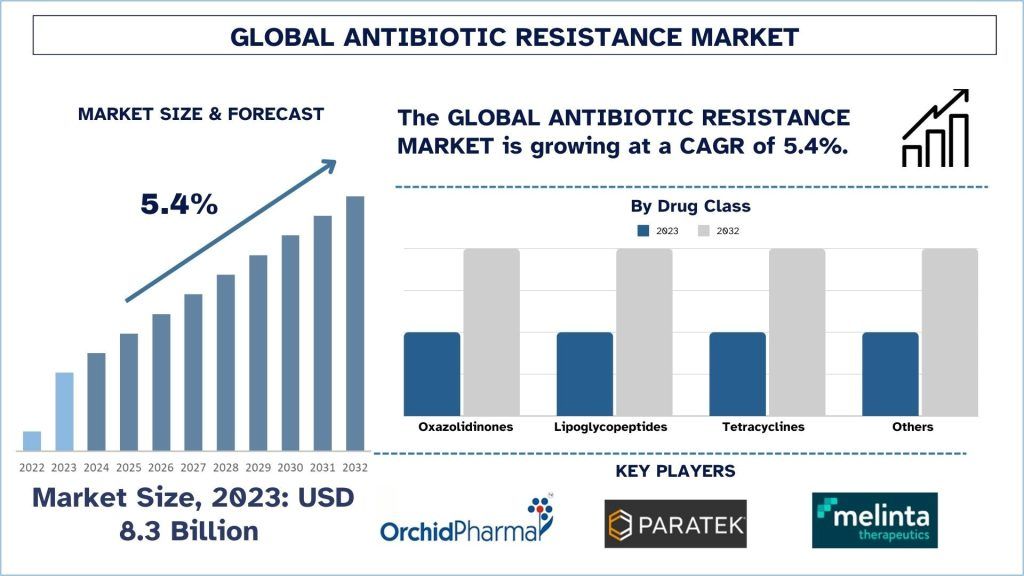- Trang chủ
- Về chúng tôi
- Ngành
- Dịch vụ
- Đọc
- Liên hệ với chúng tôi
Thị trường Kháng thuốc kháng sinh: Phân tích hiện tại và Dự báo (2024-2032)
Nhấn mạnh vào Loại Bệnh (Nhiễm trùng đường tiết niệu, Nhiễm trùng ổ bụng, Nhiễm trùng huyết, Nhiễm trùng Clostridium Difficile, và Các bệnh khác); Loại mầm bệnh (Acinetobacter baumannii, Pseudomonas aeruginosa, Staphylococcus aureus, Streptococcus pneumoniae, và Các mầm bệnh khác); Nhóm thuốc (Oxazolidinones, Lipoglycopeptides, Tetracyclines, và Các thuốc khác); và Khu vực/Quốc gia
Kích thước & Dự báo Thị trường Kháng kháng sinh
Thị trường kháng kháng sinh được định giá khoảng ~8,3 tỷ USD vào năm 2023 và dự kiến sẽ tăng trưởng với tốc độ CAGR mạnh mẽ khoảng 5,4% trong giai đoạn dự báo (2024-2032) do số ca nhiễm trùng kháng kháng sinh ngày càng tăng và đầu tư ngày càng tăng vào các hoạt động nghiên cứu & phát triển kháng sinh trên toàn cầu.
Phân tích Thị trường Kháng kháng sinh
Thị trường kháng kháng sinh (AMR) có thể được coi là một thị trường mới nổi vì nó liên quan đến một mối đe dọa mới đối với sức khỏe thế giới - kháng kháng sinh. Điều này thậm chí còn tăng lên khi nhiều loại kháng sinh hiện đại không thể thực hiện được lời hứa này vì các sinh vật kháng đa thuốc đã phát triển các cách để chúng có thể khắc phục tác dụng của các loại thuốc này. Các chất xúc tác chính cho thị trường là tỷ lệ nhiễm trùng ngày càng tăng, bao gồm cả những bệnh nhiễm trùng mắc phải ở bệnh viện và sự nhận thức được cải thiện của nhân viên y tế và dân số về tác động của AMR. Các cơ quan và tổ chức quốc gia đầu tư vào các giai đoạn đầu của nghiên cứu và phát triển, sự tiến bộ của các phương pháp chẩn đoán, vắc-xin và các chiến lược quản lý.
Những phát triển gần đây trên thị trường:
- Vào tháng 8 năm 2023, Đối tác Nghiên cứu và Phát triển Kháng sinh Toàn cầu (GARDP) đã khởi động một nghiên cứu quan sát ở Ấn Độ, nghiên cứu này sẽ làm sáng tỏ công tác quản lý nhiễm trùng kháng kháng sinh trong bệnh viện.
Xu hướng Thị trường Kháng kháng sinh
Phần này thảo luận về các xu hướng thị trường chính đang ảnh hưởng đến các phân khúc khác nhau của thị trường kháng kháng sinh, như được xác định bởi nhóm các chuyên gia nghiên cứu của chúng tôi.
Phân khúc Nhiễm trùng Huyết chuyển đổi ngành
Sự gia tăng liên tục trong phân khúc nhiễm trùng máu (BSI) kháng kháng sinh dự kiến là do số lượng ngày càng tăng của các sinh vật kháng đa thuốc, bao gồm cả vi khuẩn Gram âm như Klebsiella pneumoniae và Escherichia coli. Báo cáo liên tục về mức độ kháng thuốc cao hơn đối với kháng sinh truyền thống trong số các mầm bệnh như vậy, nhu cầu điều trị ngày càng tăng. Hơn nữa, nhiễm trùng huyết đe dọa tính mạng và phức tạp, đồng thời dẫn đến tỷ lệ tử vong cao ở bệnh nhân nhập viện và những người bị suy giảm miễn dịch. Điều này đã thúc đẩy các công ty dược phẩm cố gắng đưa ra các loại kháng sinh mới, với các tác dụng khác nhau và sự kết hợp của các liệu pháp có tác dụng tốt chống lại các chủng vi khuẩn kháng thuốc.
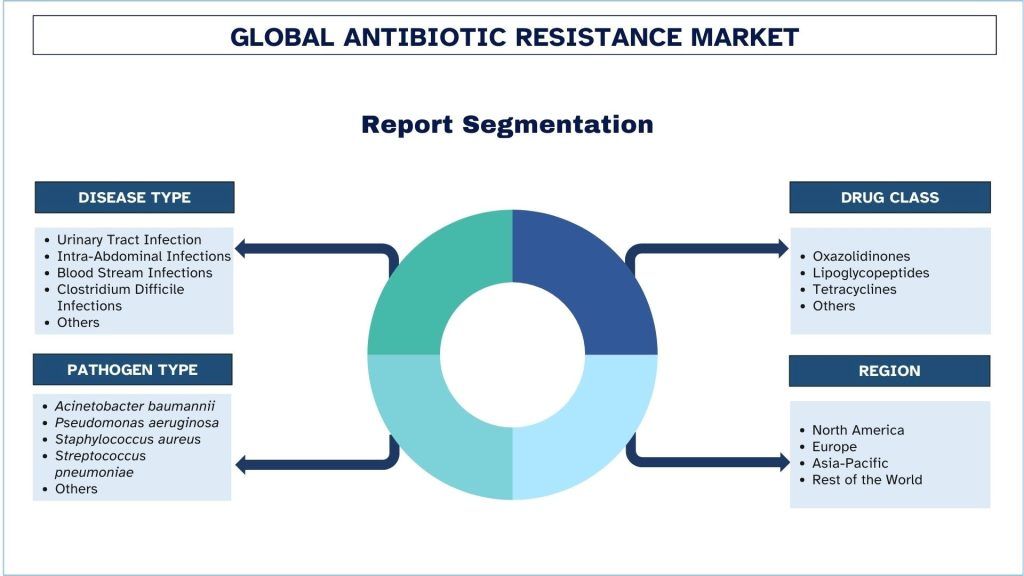
Châu Á - Thái Bình Dương dự kiến sẽ thống trị thị trường trong giai đoạn dự báo
Thị trường này đã phát triển ở khu vực Châu Á - Thái Bình Dương (APAC) do tỷ lệ nhiễm trùng cao, sự xuất hiện của nhiều mầm bệnh kháng kháng sinh hơn và nhận thức về mối đe dọa sinh học của AMR. Sự gia tăng các bệnh nhiễm trùng liên quan đến chăm sóc sức khỏe và các bệnh nhiễm trùng mắc phải trong cộng đồng cắt ngang các khu vực chứng kiến tỷ lệ đô thị hóa gia tăng, thay đổi lối sống của dân số và các biện pháp kiểm soát nhiễm trùng kém. Các cơ quan toàn cầu và quốc gia đang tập trung vào việc thực hiện các kế hoạch hành động quốc gia để đối phó với tình trạng kháng kháng sinh, điều này đã làm tăng nguồn tài trợ cho đổi mới kháng sinh và các phương pháp điều trị mới. Các khu vực này cũng đang trải qua một luồng đầu tư ngày càng tăng vào các công nghệ chẩn đoán nhanh chóng như là cơ bản như xác định các chủng kháng thuốc và các phương pháp điều trị chính xác.
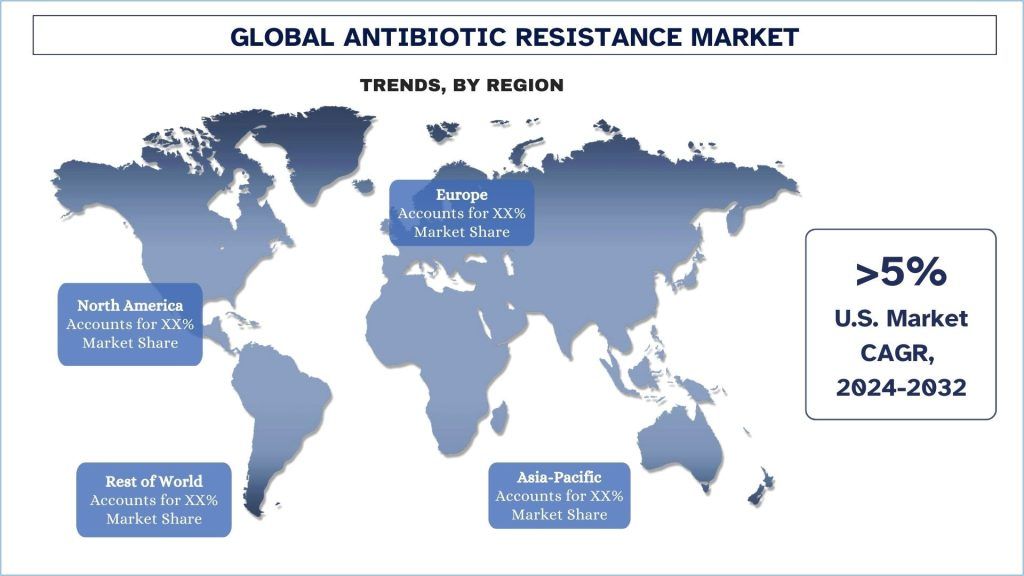
Tổng quan về Ngành Kháng kháng sinh
Thị trường kháng kháng sinh có tính cạnh tranh, với một số công ty tham gia thị trường toàn cầu và quốc tế. Các công ty lớn đang áp dụng các chiến lược tăng trưởng khác nhau để tăng cường sự hiện diện trên thị trường của họ, chẳng hạn như quan hệ đối tác, thỏa thuận, hợp tác, mở rộng địa lý, sáp nhập và mua lại. Một số công ty lớn hoạt động trên thị trường là Pfizer Inc.; Orchid Chemicals & Pharmaceuticals Limited; Melinta Therapeutics, LLC; Innoviva Specialty Therapeutics; Basilea Pharmaceutica Ltd; Wockhardt Limited; Paratek Pharmaceuticals, Inc.; Seres Therapeutics, Inc.; Cipla; Merck & Co. Inc.
Tin tức Thị trường Kháng kháng sinh
- Vào tháng 3 năm 2024, Pfizer thông báo rằng Ủy ban Sản phẩm Thuốc cho Người sử dụng (CHMP) của Cơ quan Dược phẩm Châu Âu (EMA) đã thông qua một ý kiến tích cực, khuyến nghị cấp giấy phép lưu hành trên thị trường cho EMBLAVEO (aztreonam-avibactam) trong điều trị cho bệnh nhân người lớn bị nhiễm trùng trong ổ bụng phức tạp (cIAI), viêm phổi mắc phải tại bệnh viện (HAP) bao gồm viêm phổi liên quan đến máy thở (VAP) và nhiễm trùng đường tiết niệu phức tạp (cUTI), bao gồm viêm bể thận.
- Vào tháng 12 năm 2023, Orchid Pharma đã công bố sáp nhập với Dhanuka Labs, nhà quảng bá của công ty, trong một động thái quan trọng hướng tới việc đạt được sự hợp nhất và thúc đẩy mức tăng trưởng tiếp theo.
Phạm vi Báo cáo Thị trường Kháng kháng sinh
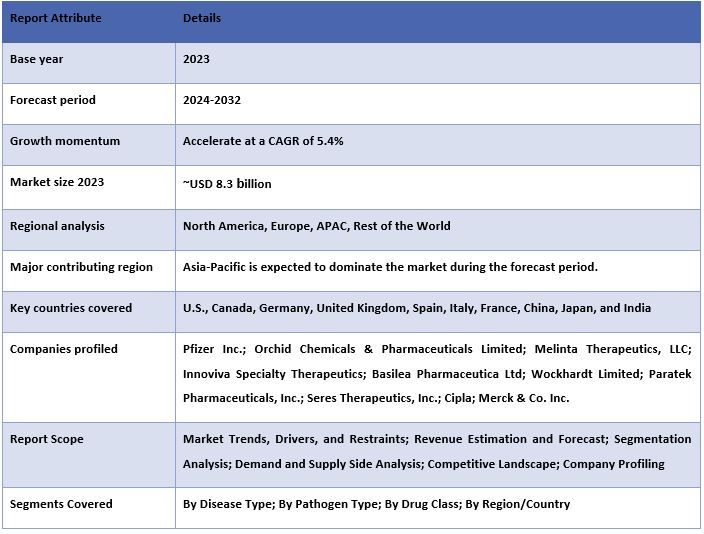
Lý do nên mua báo cáo này:
- Nghiên cứu bao gồm phân tích định cỡ và dự báo thị trường được xác thực bởi các chuyên gia hàng đầu trong ngành đã được xác thực.
- Báo cáo trình bày một đánh giá nhanh về hiệu quả hoạt động chung của ngành trong nháy mắt.
- Báo cáo bao gồm một phân tích chuyên sâu về các đồng nghiệp nổi bật trong ngành, tập trung chủ yếu vào các số liệu tài chính kinh doanh chính, danh mục sản phẩm, chiến lược mở rộng và các phát triển gần đây.
- Kiểm tra chi tiết các động lực, hạn chế, xu hướng chính và cơ hội hiện hành trong ngành.
- Nghiên cứu bao gồm toàn diện thị trường trên các phân khúc khác nhau.
- Phân tích sâu ở cấp độ khu vực của ngành.
Tùy chọn Tùy chỉnh:
Thị trường kháng kháng sinh toàn cầu có thể được tùy chỉnh thêm theo yêu cầu hoặc bất kỳ phân khúc thị trường nào khác. Bên cạnh đó, UMI hiểu rằng bạn có thể có nhu cầu kinh doanh riêng, vì vậy hãy thoải mái kết nối với chúng tôi để nhận được báo cáo hoàn toàn phù hợp với yêu cầu của bạn.
Mục lục
Phương Pháp Nghiên Cứu Phân Tích Thị Trường Kháng Sinh (2024-2032)
Phân tích thị trường lịch sử, ước tính thị trường hiện tại và dự báo thị trường tương lai của thị trường kháng sinh toàn cầu là ba bước chính được thực hiện để tạo ra và phân tích việc áp dụng kháng sinh ở các khu vực lớn trên toàn cầu. Nghiên cứu thứ cấp toàn diện đã được tiến hành để thu thập các số liệu thị trường lịch sử và ước tính quy mô thị trường hiện tại. Thứ hai, để xác thực những hiểu biết sâu sắc này, nhiều phát hiện và giả định đã được xem xét. Hơn nữa, các cuộc phỏng vấn sơ cấp toàn diện cũng đã được thực hiện với các chuyên gia trong ngành trên toàn bộ chuỗi giá trị của thị trường kháng sinh toàn cầu. Sau khi giả định và xác thực các số liệu thị trường thông qua các cuộc phỏng vấn sơ cấp, chúng tôi đã sử dụng phương pháp tiếp cận từ trên xuống/từ dưới lên để dự báo quy mô thị trường hoàn chỉnh. Sau đó, các phương pháp phân tích chi tiết thị trường và phân tích dữ liệu ba chiều đã được áp dụng để ước tính và phân tích quy mô thị trường của các phân khúc và phân đoạn con liên quan đến ngành. Phương pháp luận chi tiết được giải thích dưới đây:
Phân Tích Quy Mô Thị Trường Lịch Sử
Bước 1: Nghiên Cứu Chuyên Sâu Các Nguồn Thứ Cấp:
Một nghiên cứu thứ cấp chi tiết đã được tiến hành để có được quy mô thị trường lịch sử của thị trường kháng sinh thông qua các nguồn nội bộ của công ty như báo cáo thường niên & báo cáo tài chính, các bài thuyết trình về hiệu suất, thông cáo báo chí, v.v., và các nguồn bên ngoài bao gồm tạp chí, tin tức & bài viết, ấn phẩm của chính phủ, ấn phẩm của đối thủ cạnh tranh, báo cáo ngành, cơ sở dữ liệu của bên thứ ba và các ấn phẩm đáng tin cậy khác.
Bước 2: Phân Khúc Thị Trường:
Sau khi có được quy mô thị trường lịch sử của thị trường kháng sinh, chúng tôi đã tiến hành phân tích thứ cấp chi tiết để thu thập thông tin chi tiết về thị trường lịch sử và chia sẻ cho các phân khúc & phân đoạn con khác nhau cho các khu vực lớn. Các phân khúc chính được bao gồm trong báo cáo, chẳng hạn như loại bệnh, loại mầm bệnh, nhóm thuốc và khu vực. Phân tích sâu hơn ở cấp quốc gia đã được thực hiện để đánh giá việc áp dụng tổng thể các mô hình xét nghiệm trong khu vực đó.
Bước 3: Phân Tích Yếu Tố:
Sau khi có được quy mô thị trường lịch sử của các phân khúc và phân đoạn con khác nhau, chúng tôi đã tiến hành phân tích yếu tố chi tiết để ước tính quy mô thị trường hiện tại của thị trường kháng sinh. Hơn nữa, chúng tôi đã tiến hành phân tích yếu tố bằng cách sử dụng các biến phụ thuộc và độc lập như loại bệnh, loại mầm bệnh, nhóm thuốc và khu vực của thị trường kháng sinh. Một phân tích kỹ lưỡng đã được thực hiện cho các kịch bản phía cung và phía cầu, có tính đến các quan hệ đối tác hàng đầu, sáp nhập và mua lại, mở rộng kinh doanh và ra mắt sản phẩm trong lĩnh vực thị trường kháng sinh trên toàn cầu.
Ước Tính & Dự Báo Quy Mô Thị Trường Hiện Tại
Xác định Quy mô Thị trường Hiện tại: Dựa trên những hiểu biết sâu sắc có thể hành động từ 3 bước trên, chúng tôi đã đi đến quy mô thị trường hiện tại, những người chơi chính trong thị trường kháng sinh toàn cầu và thị phần của các phân khúc. Tất cả các phần trăm chia sẻ và phân tích thị trường cần thiết đã được xác định bằng cách sử dụng phương pháp thứ cấp đã đề cập ở trên và được xác minh thông qua các cuộc phỏng vấn sơ cấp.
Ước tính & Dự báo: Để ước tính và dự báo thị trường, trọng số đã được gán cho các yếu tố khác nhau bao gồm các yếu tố thúc đẩy & xu hướng, hạn chế và cơ hội có sẵn cho các bên liên quan. Sau khi phân tích các yếu tố này, các kỹ thuật dự báo có liên quan, tức là phương pháp tiếp cận từ trên xuống/từ dưới lên đã được áp dụng để đưa ra dự báo thị trường cho năm 2032 cho các phân khúc và phân đoạn con khác nhau trên các thị trường lớn trên toàn cầu. Phương pháp nghiên cứu được áp dụng để ước tính quy mô thị trường bao gồm:
- Quy mô thị trường của ngành, về doanh thu (USD) và tỷ lệ chấp nhận của thị trường kháng sinh trên các thị trường lớn trong nước.
- Tất cả các phần trăm chia sẻ, phân tích và chia nhỏ các phân khúc và phân đoạn con của thị trường.
- Những người chơi chính trong thị trường kháng sinh toàn cầu về các sản phẩm được cung cấp. Ngoài ra, các chiến lược tăng trưởng được các công ty này áp dụng để cạnh tranh trong thị trường đang phát triển nhanh chóng.
Xác Thực Quy Mô và Thị Phần Thị Trường
Nghiên cứu Sơ cấp: Các cuộc phỏng vấn chuyên sâu đã được thực hiện với những Người Có Ý kiến Chủ chốt (KOL) bao gồm các Giám đốc Điều hành Cấp cao (CXO/VP, Trưởng phòng Kinh doanh, Trưởng phòng Marketing, Trưởng phòng Vận hành, Trưởng phòng Khu vực, Trưởng phòng Quốc gia, v.v.) trên khắp các khu vực lớn. Các phát hiện nghiên cứu sơ cấp sau đó đã được tóm tắt và phân tích thống kê đã được thực hiện để chứng minh giả thuyết đã nêu. Thông tin đầu vào từ nghiên cứu sơ cấp đã được hợp nhất với các phát hiện thứ cấp, do đó biến thông tin thành những hiểu biết sâu sắc có thể hành động.
Phân Bổ Người Tham Gia Sơ Cấp ở Các Khu Vực Khác Nhau
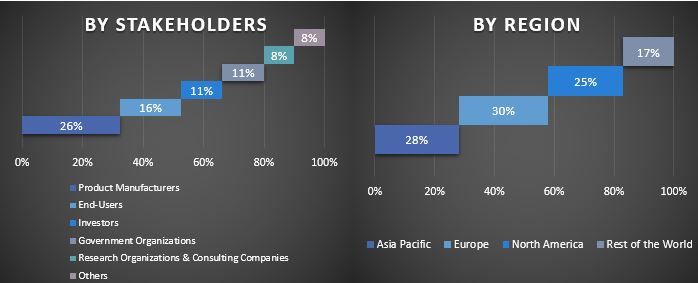
Kỹ Thuật Thị Trường
Kỹ thuật phân tích dữ liệu ba chiều đã được sử dụng để hoàn thành việc ước tính thị trường tổng thể và đưa ra các số liệu thống kê chính xác cho từng phân khúc và phân đoạn con của thị trường kháng sinh toàn cầu. Dữ liệu được chia thành nhiều phân khúc và phân đoạn con sau khi nghiên cứu các thông số và xu hướng khác nhau trong các lĩnh vực loại bệnh, loại mầm bệnh, nhóm thuốc và khu vực trong thị trường kháng sinh toàn cầu.
Mục tiêu chính của Nghiên Cứu Thị Trường Kháng Sinh Toàn Cầu
Các xu hướng thị trường hiện tại & tương lai của thị trường kháng sinh toàn cầu đã được chỉ ra trong nghiên cứu. Các nhà đầu tư có thể đạt được những hiểu biết sâu sắc về chiến lược để dựa trên quyết định đầu tư của họ dựa trên phân tích định tính và định lượng được thực hiện trong nghiên cứu. Các xu hướng thị trường hiện tại và tương lai xác định sức hấp dẫn tổng thể của thị trường ở cấp khu vực, cung cấp một nền tảng cho người tham gia công nghiệp khai thác thị trường chưa được khai thác để hưởng lợi từ lợi thế của người đi đầu. Các mục tiêu định lượng khác của các nghiên cứu bao gồm:
- Phân tích quy mô thị trường hiện tại và dự báo của thị trường kháng sinh về giá trị (USD). Đồng thời, phân tích quy mô thị trường hiện tại và dự báo của các phân khúc và phân đoạn con khác nhau.
- Các phân khúc trong nghiên cứu bao gồm các lĩnh vực loại bệnh, loại mầm bệnh, nhóm thuốc và khu vực.
- Xác định và phân tích khuôn khổ pháp lý cho kháng sinh
- Phân tích chuỗi giá trị liên quan đến sự hiện diện của nhiều trung gian, cùng với việc phân tích hành vi của khách hàng và đối thủ cạnh tranh trong ngành.
- Phân tích quy mô thị trường hiện tại và dự báo của thị trường kháng sinh cho khu vực chính.
- Các quốc gia chính của các khu vực được nghiên cứu trong báo cáo bao gồm Châu Á Thái Bình Dương, Châu Âu, Bắc Mỹ và Phần còn lại của Thế giới
- Hồ sơ công ty của thị trường kháng sinh và các chiến lược tăng trưởng được các công ty tham gia thị trường áp dụng để duy trì trong thị trường đang phát triển nhanh chóng.
- Phân tích chuyên sâu ở cấp khu vực của ngành.
Câu hỏi thường gặp Câu hỏi thường gặp
Câu hỏi 1: Quy mô thị trường kháng kháng sinh hiện tại và tiềm năng tăng trưởng là bao nhiêu?
Câu hỏi 2: Đâu là những yếu tố thúc đẩy sự tăng trưởng của thị trường kháng kháng sinh?
Q3: Phân khúc nào chiếm thị phần lớn nhất trong thị trường kháng kháng sinh theo loại bệnh?
Q4: Các công nghệ và xu hướng mới nổi trong thị trường kháng kháng sinh là gì?
Câu 5: Khu vực nào sẽ chiếm lĩnh thị trường kháng kháng sinh?
Liên quan Báo cáo
Khách hàng đã mua mặt hàng này cũng đã mua

